
The porae, the grey morwong, blue morwong, butterfish, Douglas' morwong, Eastern blue morwong, great perch, queen snapper, rubberlip morwong or silver morwong, is a species of marine ray-finned fish, traditionally regarded as belonging to the family Cheilodactylidae, the members of which are commonly known as morwongs. It is found around south eastern Australia and the north eastern coast of the North Island of New Zealand at depths of about 10 to 100 metres, on sandy and rocky coasts.
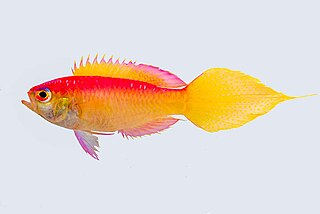
Callanthiidae, the splendid perches and groppos is a small family of marine ray-finned fishes in the order Spariformes. These fishes are mainly found in the Indo-Pacific but two species are found in the eastern Atlantic and Mediterranean.
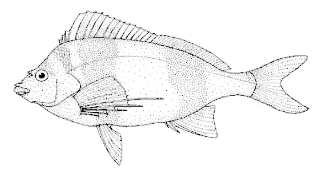
The magpie perch, magpie morwong or black-striped morwong, is a species of marine ray-finned fish, traditionally regarded as belonging to the family Cheilodactylidae, the members of which are commonly known as morwongs. It is found off southern Australia and northern New Zealand from shallow depths to 250 m (820 ft).
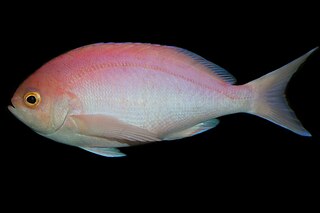
The pink maomao, also known as the longfin perch, is a species of marine ray-finned fish, a member of the family Anthiadidae. It is found in the southern Pacific and the southeastern Indian Ocean.

Helicolenus percoides, the reef ocean perch, coral cod, coral perch, Jock Stewart, kuriarki, ocean perch, red gurnard perch, red gurnard scorpionfish, red ocean perch, red perch, red rock perch, scarpee or sea perch, is a species of marine ray-finned fish belonging to the subfamily Sebastinae, part of the family Scorpaenidae. It is found in the southwestern Pacific Ocean.

The silver drummer, also known as the buff bream, buffalo bream, buffs, common buffalo bream, drummer bream, Southern silver drummer or Sydney drummer, is a species of marine ray-finned fish, a sea chub from the family Kyphosidae. It is found in the southeastern Indian Ocean and the southwestern Pacific Ocean off Australia and New Zealand where it is found in shallow water near rocky reefs.

Naso vlamingii, the bignose unicornfish, scibbled unicornfish, Vlaming's unicornfish, and zebra unicornfish, is a species of marine ray-finned fish belonging to the family Acanthuridae, the surgeonfishes, unicornfishes and tangs. This species is found in the Indo-Pacific.
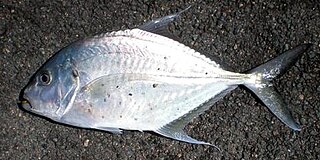
The longnose trevally, also known as the tea-leaf trevally, club-nosed trevally, grunting trevally or dusky trevally, is a species of inshore marine fish in the jack family, Carangidae. The species is distributed throughout the tropical and subtropical waters of the Indian and west Pacific Oceans from South Africa to New Zealand and Japan, inhabiting coastal waters, especially reefs, to a depth of 90 m. The longnose trevally is distinguished from similar species by a combination of a scaleless breast and the number of gill rakers and fin rays. It is a moderately large fish, growing to a maximum known length of 72 cm and 4.35 kg. The longnose trevally is a predatory fish, consuming small fish, crustaceans and molluscs. The species is of minor commercial importance throughout its range, and is considered to be a good table fish.

Genicanthus bellus, the ornate angelfish, bellus angelfish or bellus lyretail angelfish, is a species of marine ray-finned fish, a marine angelfish belonging to the family Pomacanthidae. It is found in the Indo-Pacific region.
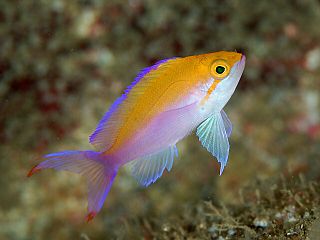
Pseudanthias bicolor, the bicolor anthias or yellowback basslet is a species of marine ray-finned fish from the subfamily Anthiinae of the family Serranidae, the groupers and sea basses. It is from the Indo-Pacific Ocean. It occasionally makes its way into the aquarium trade. It grows to a size of 13 cm in length.

Acanthurus maculiceps, the white-freckled surgeonfish, yellow-freckled surgeonfish, pale-lined surgeonfish,spotted-faced surgeonfish or earbar surgeonfish, is a species of marine ray-finned fish belonging to the family Acanthuridae, the surgeonfishes, unicornfishes and tangs. This species is found in the Indo-West Pacific region.
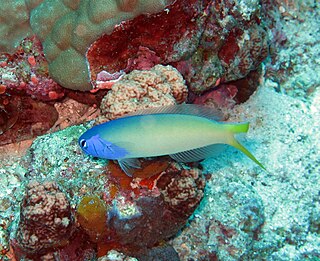
Hoplolatilus starcki, Stark's tilefish, purple-headed sand tilefish or bluehead tilefish, is a species of marine ray-finned fish, a tilefish belonging to the family Malacanthidae. This species is native to the central Indo-Pacific.
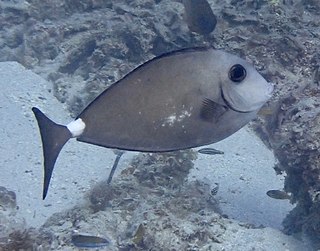
Naso fageni, the horseface unicornfish or blunt unicornfish, is a species of marine ray-finned fish belonging to the family Acanthuridae, the surgeonfishes, unicornfishes and tangs. This fish is found in the Indo-Pacific region.
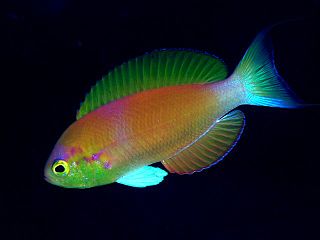
Callanthias is a genus of marine ray-finned fishes belonging to the family Callanthiidae. These fishes are primarily found in subtropical parts of the Pacific Ocean, with one species marginally in the Indian Ocean and two species in the eastern Atlantic Ocean.

Grammatonotus is a genus of marine ray-finned fishes belonging to the family Callanthiidae, which includes the splendid perches and groppos. These fishes are found in the Indian and Pacific Ocean. All of the species in the genus are known in English as groppos.
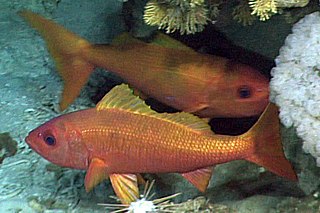
Randall's snapper is a species of ray-finned fish, a snapper belonging to the family Lutjanidae. It is native to the Indo-Pacific region.
Callanthias legars, the goldie or African splendid perch, is a species of marine ray-finned fish belonging to the family Callanthiidae. This species is found in the southeastern Atlantic Ocean off southern Africa.

Callanthias australis, the magnificent sea perch, splendid perch, glorious groppo or Northern splendid perch, is a species of marine ray-finned fish belonging to the family Callanthiidae. This species is found in the southeastern Indian Ocean and the southwestern Pacific Ocean.

Callanthias japonicus, the Japanese splendid perch or yellowsail sea bass, is a species of marine ray-finned fish belonging to the family Callanthiidae. This species is found in the northwestern Pacific Ocean.

The parrot seaperch, also known as the bird of paradise fish or Eastern Atlantic groppo, is a species of marine ray-finned fish belonging to the family Callanthiidae, the splendid perches and groppos. This fish is found in the northeastern Atlantic and Mediterranean.


















